
* While the facts in the case of the Kennedy assassination were disputed for decades, there was really never much ambiguity to them. Lee Harvey Oswald was a calamity waiting for a place to happen; when the opportunity arose, the calamity happened, leaving three people dead in the end. The sequence of events was as straightforward and chaotic as a fall down a flight of stairs.
* Lee Harvey Oswald was born in New Orleans, Louisiana, on 18 October 1939. His mother was Marguerite Oswald, his father was Robert E. Lee Oswald, who had been Marguerite Oswald's second husband and had died two months before the birth. Marguerite had two other sons, Robert Oswald and John Pic, Pic being the son of Marguerite's first husband. It was not much of a happy family, Robert and John later having little good to say about their mother, describing her as unbalanced and mean-spirited.
Lee had an unsettled childhood, having no father to provide much guidance, and being moved around a good deal. In the summer of 1952, Marguerite took Lee to New York City. He bounced from one school to another, often absent from classes; his truancy led the authorities to look into the boy's case. He was examined by a psychiatrist, who found the boy angry, withdrawn, antisocial. Revealingly, Lee told a psychiatrist: "I don't want a friend and I don't talk to people." When asked if he preferred the company of boys or girls, he replied: "I dislike everybody."
Case workers recognized that Marguerite seemed to be a big part of Lee's problems, the mother being both overly indulgent and overly controlling, and so getting him out of her custody seemed like a good idea -- to the authorities at least. Of course Marguerite didn't like it, and at the beginning of 1954, she took Lee back to New Orleans. The authorities in New York City had no jurisdiction out of state and Lee basically dropped off their radar screen.
Those who knew Lee after he came back to New Orleans found him standoffish, insolent, and inclined to get into fights. For whatever reason, he started reading about communism and was taken with the idea, though he never really investigated the subject in depth and never joined the communist party. Robert Oswald later suggested that Lee got into communism just to be rebellious -- he was, in modern usage, trolling. Otherwise, Lee didn't seem to have much in the way of interests. He finally dropped out of school to worked at menial jobs.
Lee looked up to Robert, who had been a Marine, and so Lee wanted to be a Marine as well. When Lee turned 17 in October 1956, he promptly signed up with the USMC. He was trained as a radar operator and ended up in an air traffic control station at the air base at Atsugi, Japan. The supersecret U-2 spy plane flew out of Atsugi, and some conspiracists -- conspiracy theorists -- suggest Oswald had a spy connection to the U-2 program, but he had no clearance into the program; all he did at most was watch U-2s come and go.
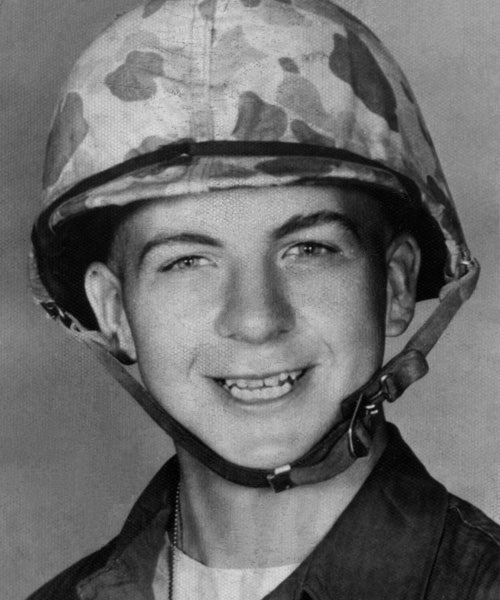
Oswald gradually became a disciplinary problem, and after he got drunk and tried to pick a fight with an NCO, he was thrown in the brig, an experience that embittered him. After he got out of the brig he rotated back to the States, serving at the Marine base at El Toro, California. By that time he was making little attempt to conceal his communist sympathies, with some of the other Marines calling him "Oswaldovich". Oswald managed to swing a "dependency discharge" to care for his "disabled" mother -- Marguerite had indeed hurt herself, but not severely; she had talked a doctor into declaring her disabled so she could get payments. He got out of the Marines in late September 1959, and promptly took a freighter to Europe. His ultimate destination was Moscow, where he arrived on 16 October.
On arrival in the USSR, Oswald asked for Soviet citizenship. He wasn't wanted. The Soviets had plenty of experience with nobodies like Oswald, and had found them far more trouble than they were worth. Oswald was debriefed, but as one official later said: "There were conversations, but this was such outdated information, the kind we say the sparrows had already chirped to the entire world, and now Oswald tells us about it."
The KGB saw no value in him, and thought him unstable. The Soviets turned down his request for citizenship; he slashed his wrist and had to be rushed to the hospital for blood transfusions. After the suicide attempt, the KGB was even more certain they didn't want Oswald, but they were also not sure of what to do with him. The US and the USSR were in one of their periods of trying to get along, and the authorities didn't want to mistreat their American guest. Oswald was granted a temporary right to stay and sent to the city of Minsk, where he was kept under passive surveillance by the KGB. Any active interaction with him by KGB personnel was strictly forbidden.
Oswald got a job in a factory and, with the help of a stipend provided by the government, it seems as a reward for defecting, was making good money by Soviet standards. However, life in the USSR didn't match the fantasy he had put together in his head of a classless utopia, and by the end of 1960 he had become disillusioned. By early 1961, he was writing the US embassy for help in returning to the USA. His efforts to go home were complicated by the fact that he then married a Russian girl named Marina Prusakova. Soviet authorities would have been happy to see him go, but they weren't keen on letting a Soviet citizen out. Oswald persisted, and managed to finally leave the country in June 1962. By this time the couple had a baby, a girl named June.
* All but penniless, Oswald and his little family ended up living in the house of his brother Robert in Fort Worth, Texas. The FBI interviewed Lee, to find him uncooperative. The FBI would check up on him every now and then, though the bureau didn't think he represented a threat; he had no criminal history, and he wasn't in any position to be a useful spy. Spy? Spy on what? However, Oswald would increasingly see the FBI as persecuting him.
Oswald got a job with the Leslie Welding Company in July and moved his family to a seedy rental house. He stayed at Leslie until October, when he decided to change jobs, finding work at the Jaggars-Chiles-Stovall Company, a Dallas graphics-arts firm, working in photoprinting. He relocated his family to Dallas in November. By that time, he was becoming abusive to Marina, beating her on occasion. She put up with it because she had nowhere else to go, and in fact Lee used the threat to send her back to the USSR to keep her in line.
In February, the Oswalds ran into a couple named Michael and Ruth Paine at a dinner party. The Paines were both American Civil Liberties Union (ACLU) members, liberal activists in conservative Texas. Ruth, a Quaker, was trying to learn Russian and took a sympathetic interest in Marina Oswald. The Paines would get to know the Oswalds about as well as anyone ever did.
* Although Oswald didn't have much money to spare, he did decide to buy a 0.38-caliber Smith & Wesson revolver and an Italian war surplus 6.5-millimeter Carcano rifle through the mails. The weapons were purchased in the name of "A. Hidell"; Oswald used the facilities at Jaggers to create fake ID for "Alek Hidell" to allow him to pick up the weapons when they arrived, by coincidence together, on 24 March. On 31 March, he had Marina take pictures of him in the back yard wielding the Carcano rifle, with the revolver stuck into his belt. He developed them himself and wrote "For Junie from Papa" on the back of one. Marina was baffled as to why Junie would want such a photo, and he told her: "To remember Papa by sometime." One of the photos was later discovered inscribed with: "Hunter of Fascists, Ha, Ha, Ha", it seems by Marina. Conspiracists assert the "Fascist Hunter" photos are fakes, but all professional examination showed them to be for real.
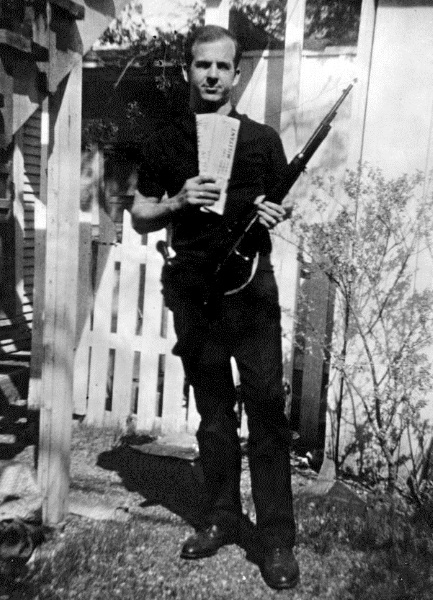
Jaggars didn't like Oswald's work habits and poor people skills, so they fired him on 1 April. He didn't tell Marina right away. Out of work, he spent part of his time scoping out the home of Edwin Walker, a retired US Army General and prominent local Rightist. On Wednesday, 10 April, Lee told Marina he had been fired. He went out after dinner, with Marina then finding a list of instructions written by Lee in Russian for her, telling her the bills had been paid up, he'd left her a bit of money, and concluding by telling her that "if I am alive and taken prisoner" where she could find the jail. Marina started shaking; by the time Lee came back, she was frantic.
While Lee was out, somebody had taken a shot at Walker while he was working on his income taxes in his dining room. Walker barely missed getting a bullet in his head by a freak of luck; the bullet hit the wood framing in the middle of the window, which deflected it. As Walker himself explained later, the light in the room coming out would have flooded around the narrow strip of framing, rendering it invisible in the scope of the rifle. Lee had come home in a state of excitement and told Marina that he'd tried to kill Walker, saying: "I missed." Marina concluded Lee was deranged, but was fearful of going to the authorities lest she be considered an accomplice.
* Unemployed, Lee Harvey Oswald had to determine what to do next. Oswald decided to move back to New Orleans -- Marina later said she encouraged the move, thinking that if he stayed he might try to kill Walker again. Oswald left Dallas on a bus on Wednesday, 24 April 1963, with Marina and baby June staying behind with the Paines at their house in the Dallas suburb of Irving for the moment. He found a job on 9 May with the Reily Coffee Company, maintaining the machinery. He got himself an apartment and had his family join him. In New Orleans, Oswald became increasingly obsessed with Fidel Castro and the communist Cuban state. Oswald got in touch with a national organization named "Fair Play For Cuba", and decided to open up a New Orleans chapter; he was the only member.
Oswald's work habits at Reily weren't any better than they had been at Jaggers -- he was fond of pointing a finger at people and saying: "Pow!" -- and he was fired on 19 July. To collect unemployment benefits he had to report to the Louisiana Employment Commission the job applications he had made, and he mostly just fabricated them; by that time, he routinely lied about everything.
With no job, Oswald focused on his Fair Play For Cuba activities, while simultaneously trying to "infiltrate" an anti-Castro Cuban group, claiming he could train them in guerrilla operations. Oswald was apparently playing James Bond; the Cubans were unsurprisingly suspicious of him, and when they spotted on 9 August him handing out Fair Play for Cuba flyers on the street, there was a confrontation, with the police arresting both Oswald and the Cubans. The Cubans were released, Oswald had to pay a $10 USD fine. He persisted in his solitary efforts for Fair Play for Cuba, even getting a little publicity on a radio talk show -- which backfired when the lies he told in interviews caught up with him, the publicity just making him out a fool and a fraud.
After the public humiliation, Oswald dropped his political activism, such as it was, with Marina finding his behavior increasingly erratic. He started playing a lot more with his rifle; Marina asked him why, and he replied, to her shock, he was thinking of hijacking an airliner to Cuba. Marina finally managed to convince Lee that he might come up with a less drastic way of getting to Cuba. He decided to go to Mexico and visit the Cuban embassy in hopes of being allowed entry to Cuba. Ruth Paine was to take Marina and June back to Dallas; Paine showed up with her kids on 20 September, and left on Monday, 23 September, with Marina and June to stay at the Paine's house. On her departure, Marina wasn't sure she'd ever see Lee again.
* Oswald left New Orleans on 25 September, arriving in Mexico City on a bus on 27 September, a Friday. He went to the Cuban embassy that day and tried to get a visa; the embassy staff wasn't inclined to give him one, suggesting that it would help if he got a Soviet visa first, sending him over to the Soviet embassy. They didn't know what to make of him there and told him to come back on Saturday. After he left, the embassy staff wired Moscow about Oswald, and got back a reply telling them to politely get rid of him. When Oswald came back on Saturday, they blew him off, and he threw a raving fit. After he left, the embassy staff judged him "psychotic". Oswald went back to the Cuban embassy and they blew him off too, resulting in another fit.
Oswald bummed around in Mexico City for a few days, finally leaving on Wednesday, 2 October. The US Central Intelligence Agency (CIA) had a presence in Mexico City and was keeping an eye on the embassies; they did take note of Oswald's visits to them, but botched everything, sending in a report about a "Lee Henry Oswald", and obtaining a photograph of the wrong person.
Oswald returned to Dallas to look for work. Marina remained with Ruth Paine, while he found lodging in a boardinghouse. In mid-October, Ruth was talking to some neighbors about Oswald's search for work. One, Linnie Mae Randall, said that her brother, Wesley Buell Frazier, had got a job downtown at the Texas School Book Depository (TSBD), a privately-operated textbook distribution center, and that the TSBD needed temporary help. Oswald went to the TSBD on 15 October, speaking to a supervisor named Roy Truly; Oswald made a good impression, and Truly hired him. Frazier was living at his sister's house near the Paine residence at the time, and on learning that Oswald visited his wife there on weekends, offered to give him a lift if he needed it.
Marina gave birth to a second child on 20 October, the baby girl being named Audrey. Oswald seemed to have mellowed on his return to Dallas from Mexico, but it was only temporary; after the birth of Audrey he began to revert to form, pushing Marina around and acting surly.
BACK_TO_TOP* US President John F. Kennedy (JFK) had decided to perform what amounted to a campaign tour of Texas in a meeting with Vice-President Lyndon Baines Johnson (LBJ), a Texan, and Texas Governor John Connally on 5 June 1963. The president was to make appearances in five Texan cities, in order of San Antonio, Houston, Fort Worth, Dallas, and Austin. JFK's visit to Dallas was planned for 22 November 1963. The president and his entourage were to fly into Love Field in Dallas in the morning, with a motorcade to travel from the airport to the Dallas Trade Mart, where he would give a speech. The motorcade would pass through Dealey Plaza, a public square on which the Texas Book Depository bordered. The route of the motorcade was described in the Dallas papers on 19 November 1963, and a map of the route published to allow the public to observe the visit.
Oswald liked to read the papers, making a point of going through them each morning in the lunchroom on the first floor of the depository. He couldn't have missed the front-page articles from 19 November that showed the motorcade route went down Elm Street, right in front of the TSBD. On Thursday, 21 November, he asked Frazier for a lift to Irving. It was the first time he went to the Paine house on a weekday. Frazier dropped him off at the Paines' house that evening. Lee ate dinner with Marina and the Paines, acting very taciturn; Marina brought up the presidential visit to Dallas, but he wouldn't comment. She found that odd, and asked if he knew about the route of the president's motorcade. He replied he knew nothing about it.
Lee got up and left early the next morning. When Marina got up, she was startled to find that he had left her $170 USD on top of the bedroom bureau, which was almost all the money he had in the world. She didn't notice until later that he had also left his wedding ring in a cup on the bureau; she'd never seen him take it off before. That same morning -- Friday, 22 November 1963 -- Oswald picked up his ride from Frazier, with Oswald carrying a long item in an improvised paper bag. Frazier asked Oswald what was in the bag, and he replied: "Those are curtain rods."
When they got to the depository, Oswald seemed to be in a hurry to get inside with the package. Few saw Oswald around that morning. Towards midday, TSBD employees went to lunch and then formed up in small groups to observe the presidential motorcade, which was to go by sometime after noon. Oswald was seen on the sixth floor of the TSBD by workers when they broke for lunch, but nobody saw him again before the motorcade came by.
* JFK and his entourage had flown into Love Field as scheduled on the morning of 22 November. While it had been raining that morning, the weather soon turned sunny for the motorcade through Dallas. The president, Governor Connally, and their wives rode in an open-top 1961 Lincoln Continental limousine. The people of Dallas came out in numbers to cheer the president, damping worries that JFK would get a hostile reception. Kennedy even had the limousine stopped twice so he could get personal with citizens.
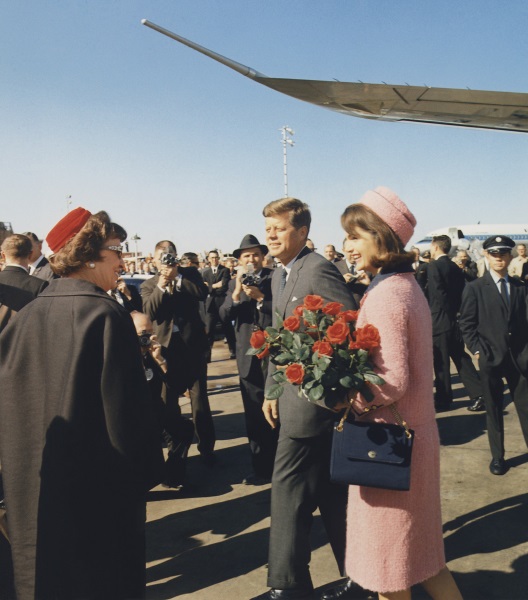
People were lining Elm Street when the motorcade arrived at 12:30. A garment manufacturer named Abraham Zapruder was standing on top of a wall, filming the motorcade with an 8-millimeter home movie camera as the president's limousine turned onto Elm; his 26.6-second film would prove to the most famous amateur movie in history. The crowd was enthusiastic, and Mrs. Connally turned to tell JFK: "Mr. President, you can't say that Dallas doesn't love you."
Kennedy replied something to the effect of: "No, you certainly can't."
Those were his final recorded words. After the limo completed the turn on to Elm Street, a shot rang out. Connally was a hunter and immediately judged the sound to be a rifle shot. He turned around to his right to see where the shot had come from, then started to turn back to his left to look at JFK and Jackie.
Three witnesses on the sidewalks saw a rifle sticking out of the northeast corner window on the sixth floor of the TSBD. One of the witnesses, a steamfitter named Howard Brennan, got a look at the shooter as well. The shooter fired again; the president's arms then jerked up to his neck level while Connally, hit, fell over onto his wife, saying: "Oh no, no, no!" The governor saw blood on his shirt and cried out: "My God, they're going to kill us all!"
A third shot then rang out and the right side of the president's head exploded in an ugly splash of blood and brain tissue. The driver of the limousine, Secret Service Agent Bill Greer, had slowed down after the second shot; now he hit the gas, with the limousine and its injured passengers speeding off to Parkland Hospital in Dallas.
On the northeast corner of the fifth floor of the TSBD, three employees of the depository had been watching the motorcade when the shooting started. They heard the shots coming from the sixth floor directly above them, with one, Harold Norman, later saying: "When the first shot came, I heard BOOM, then klik-klik BOOM, klik-klik BOOM." They could hear the tinkle of cartridge cases hitting the floor after each shot.
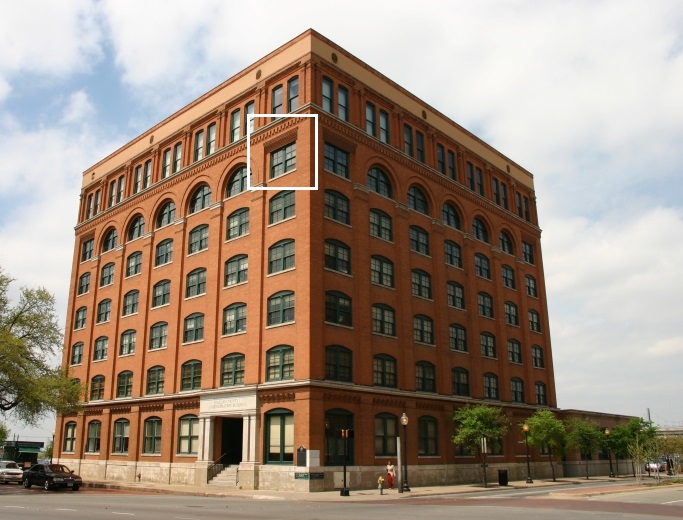
* A Dallas policeman named Marrion Baker who was in the motorcade saw pigeons flying off the roof of the TSBD. He pulled over his motorcycle and dashed inside, linking up with Roy Truly to get upstairs. They ran into Oswald on the second floor, but Truly vouched for him, and so the two men went on upstairs. Oswald left the TSBD immediately, taking a bus and then, when traffic jammed up on him, getting off and taking a taxi to near his boardinghouse. There, at a little before 1:00 PM the housekeeper, Earlene Roberts, saw him go to his room in a hurry, then leave again with a jacket on.
Howard Brennan had given his rough description of the shooter in the TSBD to the police, who had sent out an all points bulletin to patrol cars. At about 1:15 PM, Officer Jaydee Tippit -- he wrote his first name as "JD", but they weren't initials, that was his name, pronounced "jaydee" -- spotted a pedestrian matching the description of the shooter and pulled up his patrol car. It was Oswald; when Tippit got out, Oswald shot the policeman four times, killing him. Witnesses observed the shooting or Oswald fleeing the scene of the crime with a pistol in his hand.
Police cars, sirens blaring, ran up and down the streets. Oswald ducked into a shoe store to hide for a moment; the manager there, Johnny Calvin Brewer, found that suspicious and followed Oswald, who ducked into the nearby Texas Theater. Brewer had the staff in the movie house call the police, and when the police arrived, he pointed out Oswald in the audience to them. Oswald resisted arrest, even pulling his gun on the cops, but he was disarmed and hauled off to police headquarters at Dallas City Hall. He was carrying ID for Oswald and for "Hidell", so there was some confusion as to who he was until he was properly identified by a TSBD manager.
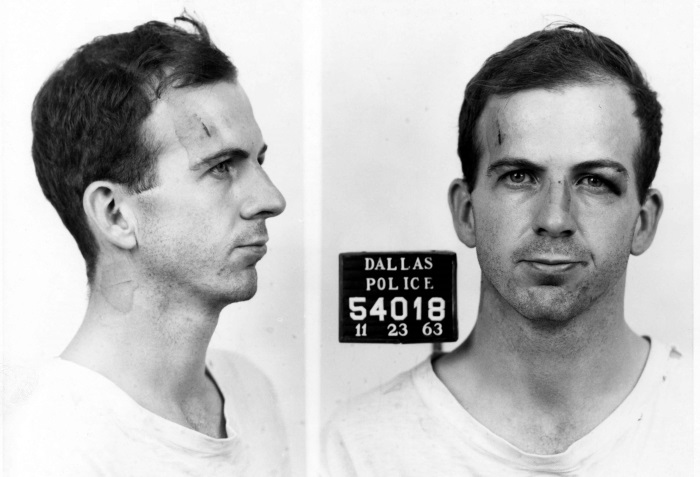
Police inspecting the TSBD found that boxes had been moved around the northeast corner of the sixth floor to provide concealment, as well as a "rifle rest" behind the window. Three empty cartridges were found in the "sniper's nest", along with an improvised paper bag. A Carcano rifle was found shoved between boxes near the stairwell.
* In the meantime, the presidential limousine arrived at Parkland Hospital, with the wounded passengers taken into Emergency. The doctors working on JFK noticed the wound in his throat immediately, but it took them about 15 minutes to notice the head wound in his thick hair. It was obviously fatal. He was given last rites by a priest and announced dead at 1:00 PM. Much has been made of the observations of the Parkland doctors of JFK's wounds, but they were frantically trying to save his life and didn't give JFK any detail inspection; they never even turned Kennedy over to examine his back. JFK's body was taken off their hands. Connally's injuries were serious, but he survived.
Kennedy's death was publicly announced at 1:33 PM. A little after 2:00 PM, JFK's body was taken in a casket to Love Field, where it was loaded into the rear of the presidential jetliner AIR FORCE ONE; a row of seats had been removed to accommodate it. At 2:38 PM, just before the departure of AIR FORCE ONE, Lyndon Johnson took the oath of office and became President of the United States.
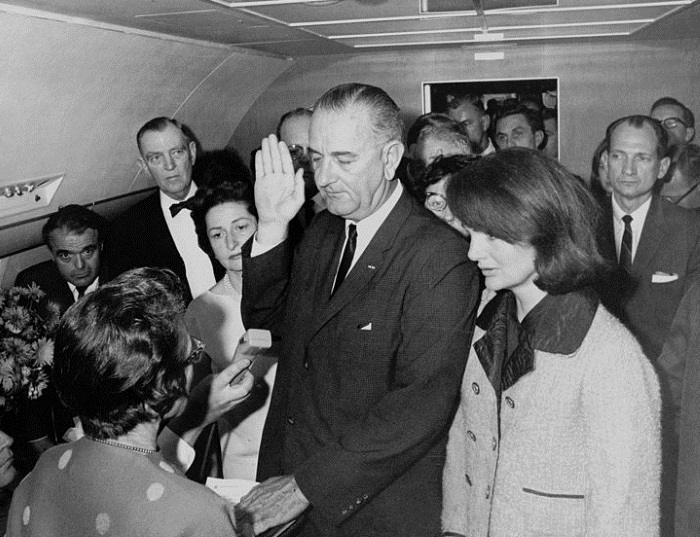
AIR FORCE ONE landed at Andrews Air Force Base near Washington DC and JFK's body was taken to Bethesda Naval Hospital in Maryland, where a team of doctors performed an autopsy that lasted until about 11:00 PM. JFK's body was then embalmed and prepared for funeral during the dark hours of the morning. Kennedy was laid to rest in Arlington National Cemetery on Monday, 25 November. The funeral was attended by representatives of 90 nations and watched on television by a collectively stunned nation.
* Oswald was not among the viewers. He had been arraigned for shooting the president and Tippit, but under repeated interrogations Oswald denied everything, telling obvious lies: "I never owned a rifle myself ... I was never in Mexico City." He claimed he was "just a patsy", that the police were trying to pin the assassination on him because he was a Red. He was put through lineups where witnesses identified him as the man who had shot Tippit.
On the morning of Sunday, 24 November 1963, Oswald was to be transferred from City Hall to the Dallas county jail; the police had been phoned death threats against him and wanted to move him to a more secure facility. However, as officers were transferring him to an armored van in the basement of City Hall at 11:21 AM, Dallas nightclub owner Jack Ruby dashed up to Oswald, shoved a revolver into his abdomen, and put one bullet into him. The shooting was caught live on national television. Oswald was rushed to Parkland Memorial Hospital, where he was pronounced dead at 1:07 PM.
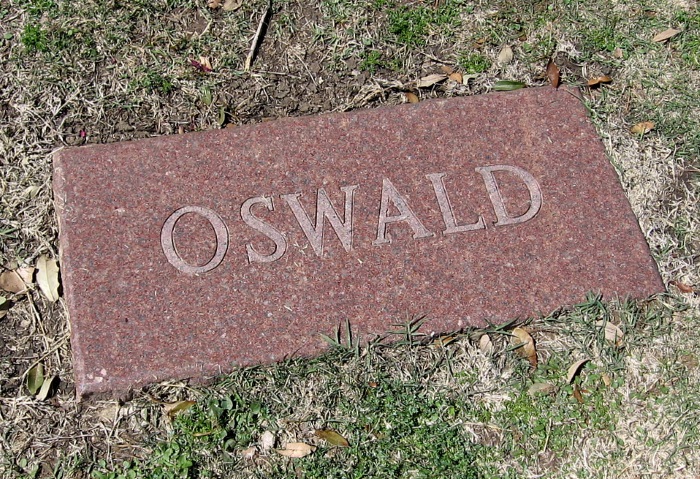
Robert Oswald took care of the burial of Lee, in the face of considerable difficulties -- one minister refusing to officiate, saying: "Your brother was a sinner." The body was exhumed in 1981, in consequence of far-fetched rumors that it wasn't really Oswald who had been buried. An autopsy confirmed his identity, and Oswald since has rested in peace.
BACK_TO_TOP* In the wake of the assassination of JFK, there was a strong public outcry for an investigation of the crime, and so on 29 November 1963 President Johnson set up a special commission, headed by Supreme Court Chief Justice Earl Warren, to investigate the assassination. After eight months of investigation the "Warren Commission" presented its final report, 888 pages long, to LBJ on 24 September 1964. The commission had examined the testimony or depositions of 552 witnesses and considered 3,100 items of evidence, with assistance from the FBI, the Secret Service, the CIA, the Army, and other government organizations.
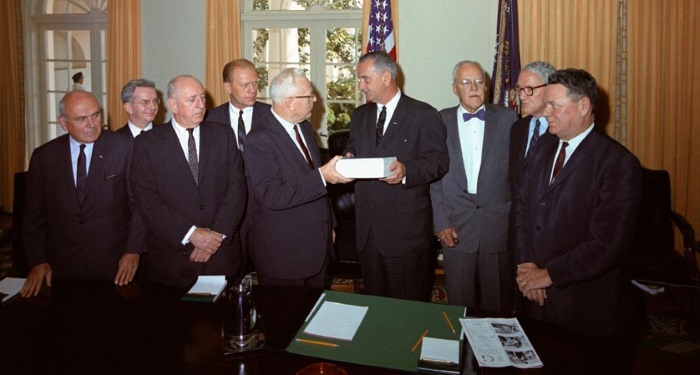
The Warren Commission concluded that three shots were fired at the presidential motorcade -- one shot missing, another striking the president through the throat and then smashing through Connally's side, the last hitting JFK in the head. The autopsy of JFK showed he was hit from above and behind. The evidence accumulated by the Warren Commission that Oswald was the shooter was overwhelming:
Oswald was entirely uncooperative with the police, refusing to say why he had been carrying a pistol, and telling obvious lies. In his mug shots, he was all but smirking at the camera. Earl Warren once commented: "You can't prove conclusively that Oswald did it, but you can get close enough to convict him in a two-day trial." Justice cannot and does not work with mathematical precision.
BACK_TO_TOP* From 1976 to 1978, the US House of Representatives also conducted an investigation of the assassination of JFK, as well as that of the 1968 murder of civil rights activist Dr. Martin Luther King JR. The "House Select Committee On Assassinations (HSCA)" published its report in 1979.
The HSCA report generally confirmed the work of the Warren Commission -- concluding that Oswald fired three shots at the presidential motorcade -- one shot missing, another striking the president through the throat and then smashing through Connally's side, the last hitting JFK in the head. Although the HSCA was critical, some believe excessively so, of the autopsy of the president performed in 1963, the report concluded that the autopsy was in all major respects correct, that he had been hit from above and behind. HSCA analysis showed the possible directions of the shots were in a "cone" centered on the northeast window on the sixth floor of the TSBD.
The HSCA also judged that the Warren Commission had failed to adequately investigate leads that suggested a conspiracy, and dug into such leads as could be found energetically. Nothing was turned up; HSCA investigators who went to Mexico City to follow up the many rumors that arose from Oswald's visit there found "not a thing." The report concluded there was no cause to believe any US government organization was involved in the assassination, and there was no evidence that could specifically identify any other groups as involved in the assassination.
There seemed to be a certain reluctance among the HSCA members to accept the findings of their own investigation, the final report saying the possibility of a conspiracy couldn't be ruled out -- like saying they didn't have any evidence Martians had visited the Earth, but couldn't say they hadn't. That reluctance then went over the bounds into desperation when, at the last moment of the investigation, researchers from the firm of Bolt, Beranek, & Newman came forward to declare that a Dallas police audio recording made on 22 November 1963 indicated a fourth shot, suggesting a second shooter, possibly firing from a "grassy knoll" south of the TSBD along Elm Street. The HSCA then announced there was, in fact, evidence of a conspiracy to kill JFK.
The "acoustic evidence" was, on the face of it, of enormous significance, since it was the only evidence of a conspiracy in the murder of JFK that was ever uncovered by an official investigation. Several members of the committee thought the acoustic evidence was much to slender a thread on which to hang so much. There actually wasn't an obviously identifiable sound of a fourth shot on the recording, which was noisy and low quality to begin with.
The acoustic evidence began to fall apart from the moment it was announced to the world. According to the scenario outlined by the HSCA, the recording was supposedly picked up from the radio on the motorcycle of Dallas Police Officer Hollis "H.B." McLain, his mike supposedly being stuck in the ON position. When McLain learned of this, he said it was nonsense:
McLain was particularly annoyed because he had gone to Washington DC to testify to the HSCA; he could have told the staff they were off base had he known what they were doing -- but they assured him he didn't need to hear the tape, restricting their questions to him to those convenient to their agenda. Along with the problems revealed by McLain, it was then pointed out that the voice chatter on the recording indicated that the fourth shot would have taken place about a minute after the third shot, by which time the presidential limousine was long gone.
As damning as these facts were to the acoustic evidence -- and nobody could credibly dispute them -- in 1982, the Justice Department still set up a panel from the US National Academy of Sciences (NAS) to examine the issue. The "Committee On Ballistic Acoustics (CBA)" included a dozen scientists, headed by Nobel Prize-winning physicist Norman Ramsey, and including Luis Alvarez, another Nobel-prize winning physicist; the committee flatly dismissed the acoustic evidence.
Later attempts to revive it went nowhere. It wasn't based on well-established forensic techniques for which there was a substantial body of experience, or which had been reviewed by a skeptical eye; once exposed to review, it collapsed like a house of cards. The bottom line of the two government investigations of the JFK assassination was that:
Oswald was too unreliable and unstable to be regarded as a useful agent; and on the other side of that coin he was nobody's "patsy", being resentful of authority, all authority, and much more inclined to manipulate others than be manipulated himself. In addition, if Oswald had been in the hire of a ruthless and efficient conspiracy, there is no way he would have been left to be arrested and questioned for almost two days; the plan would have ensured his getaway, and then his permanent disappearance.
BACK_TO_TOP* Jack Ruby was born as "Jacob Leon Rubenstein" in Chicago in 1911, the fifth of eight children of Joseph and Fannie Rubenstein, both Orthodox Jews. The parents separated when Jacob was ten. Jack was a unruly youngster, with a hot temper, inclined to get into fights, and very good at fighting. He always had a scheme to bring in a fast buck or two, but he never had any serious problems with the law. Nobody who knew him ever thought of him as very bright.
Rubenstein went to California for a while; then came back to Chicago; did a hitch Stateside in the Army Air Forces during the war; and finally moved down to Dallas, Texas in 1947, where he legally changed his name to "Jack Ruby". After many hustles and unsuccessful deals, he helped run two nightclubs, the "Carousel Club" and the "Vegas Club", working with his sister Eva Ruby Grant -- he spent most of his time running the Carousel Club, while Eva ran the Vegas Club.
Success eluded Ruby. He always had troubles staying afloat financially, and he was a Yankee in Texas, also Jewish; he didn't fit in. People who worked for him found him volatile, capable of wild mood swings, from fun-loving to violent. He was still inclined to get into fights -- sometimes with good reason, sometimes not. He often carried large sums of money around to pay off his workers and bills, and so he sometimes packed a revolver.
Ruby was something of a "gate crasher" and liked to draw attention to himself, putting on obnoxious displays of self-importance. He was friendly with the local cops, Dallas police saying he was known to about half the force. Ruby was also friendly to local gangsters, who sometimes came in and threw money around in his club, and had a few shady friends. Ruby's ties with such characters would lead to rumors that he was involved in drug dealing and prostitution, but he was never arrested or even investigated for such things.
Gangsters didn't trust Ruby. He was too friendly with the police, and he talked too much. There were tales that he had been sent to Dallas by the Chicago Mob, but the FBI checked up on his background in both locales and found nothing. Wiretaps of gangsters never mentioned Ruby; gangland informants had never heard of him. Ruby liked to hint that he had Mob connections, that he "knew all the Boys", but nobody thought there was anything to it other than Ruby trying to inflate his importance. A Dallas police detective named Jack Revill told the HSCA: "Jack Ruby was a buffoon. He liked the limelight. He was highly volatile. He liked to be recognized with people, and I would say this to the committee: if Jack Ruby was a member of organized crime, then the personnel director of organized crime should be replaced."
His rabbi, Hillel Silverman, had a similar read on him: "Jack Ruby would be the last one that I could ever trust to do anything." Those who knew Ruby also found him generally apolitical. He did like JFK and his wife Jackie, however; they had "star quality", they had "class" -- something Ruby desperately wanted, but never could remotely have.
* Some conspiracy tales had Ruby out of town or working for a conspiracy on Thursday, 21 November 1963, the day before the assassination, but he was seen around Dallas, working on his usual hustles. The next day, Friday, started out like any other for Ruby. At 11:00 AM that morning, he went to the offices of THE DALLAS MORNING NEWS to place ads for the nightclubs. Workers there saw Ruby around; when the news came that JFK had been shot, one of the newspaper staffers who was dealing with Ruby described his reaction as one of "stunned disbelief", adding that Ruby became "emotionally upset". He left the offices of THE DALLAS MORNING NEWS about 1:30 PM, clearly in a distraught frame of mind.
Reports of Ruby's movements that afternoon are confused, but he did end up at the Carousel Club, where all there found him a wreck, weeping freely -- something not at all normal for a tough guy like Ruby. He left in mid-afternoon, going to Eva's apartment, staying there until the evening. When he finally left, Eva said: "He looked pretty bad ... a broken man ..." He told her: "Someone tore my heart out."
Ruby went to a memorial service for the president at his synagogue, and then to City Hall, where he saw Oswald make a statement, and schmoozed with the reporters there. Late that night, he ran into one of his strippers, out on a date with a Dallas cop; they described Ruby as "kind of wild-eyed", fuming at that "little rat" Oswald. Ruby spent the rest of the night running around, not getting to bed until sometime around sunup on Saturday. He stayed in the apartment until noon, to then spend much of the day in incoherent drifting around town.
That evening, when he was back in his apartment, he got a call from one of his strippers, Karen Carlin, who needed a little cash -- but he didn't feel very agreeable, getting snappish with her. After further drifting around, he went to bed about 1:40 AM, early by his standards. Ruby got up at midmorning on Sunday, 24 November, to get another call from Karen Carlin, hitting him up for money again. He agreed to go to Western Union and send her a "moneygram" for $25 USD. Ruby left the apartment at about 11:00 AM and drove downtown.
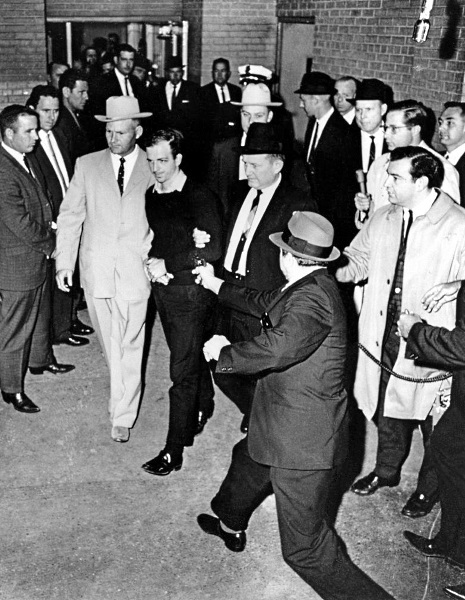
Ruby went to Western Union, where he obtained the moneygram for Carlin, being given a receipt timestamped 11:17 AM. The Western Union office was only a short distance from City Hall; Ruby walked over there and at 11:20 slipped into the Main Street ramp as a police vehicle was leaving, with the vehicle providing concealment for Ruby as he went inside. Apparently someone shouted: "HEY YOU!" -- at him, but he just walked faster. At 11:21, Ruby was walking up to the crowd of reporters inside just as Oswald was being brought out. Ruby drew his pistol and rushed in, shouting: "You killed my president, you rat!" -- putting a slug through Oswald. Oswald fell, the police tackled Ruby and dragged him off as others called an ambulance for Oswald. Oswald's wound was mortal.
* Police could not get a coherent explanation out of Ruby for why he killed Oswald; they concluded he had simply done it as an enraged impulse. Rabbi Silverman commented later: "I entered his cell. I knew him very well ... He was a very volatile, a very emotional, unbalanced person. He thought he was doing the right thing. He loved Kennedy. [Oswald] killed Kennedy. [Ruby] happened to be there ... He was impetuous, he pulled the trigger."
One of Ruby's strippers gave a similar and very perceptive read on his impulsiveness: "I think he came around there just to see what was going on. And when he saw that sneer on Oswald's face -- that's all it would take to snap Jack."
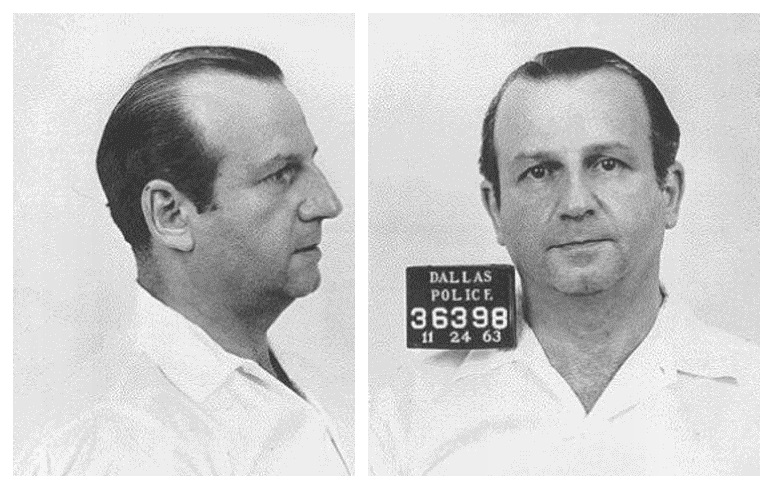
Jack's brother Earl, hoping to get the best possible deal for Jack in his murder trial, managed to get superstar lawyer Melvin Belli to take the case. It actually wasn't that challenging a case, since many Texans didn't have a big problem with Ruby killing Oswald, and the general expectation was that Ruby would get a five-year sentence.
Hiring on Belli, however, was a big mistake. Belli was a pro in torts, civil suits, and had little background in criminal cases; he was also arrogant, publicly calling Dallas folk "yokels". Belli did an overblown job on the defense that simply annoyed the jury and humiliated his client; on 14 March 1964, the jury found Jack Ruby guilty of premeditated murder, and he was then sentenced to death. Ruby's mental stability, not very good when he was arrested, continued to deteriorate during the trial and afterward. He had fantasies of Jews being slaughtered, with the guards reporting that he would put his ear to the wall and say: "Shh! Do you hear the screams? They're torturing the Jews again down in the basement!"
Since Ruby was behind bars, the Warren Commission decided to visit him in Dallas, for the sake of security: taking Ruby to Washington DC would create too many opportunities for someone to kill him. Warren himself was part of the group that talked to Ruby on 7 June 1964. Conspiracists make much of Ruby's declaration of a conspiracy to kill JFK during the interview; they particularly play up the fact that Ruby said he had to go to Washington DC to tell his story.
Anyone who would say such things has made a very selective reading of the transcript of the interview. The first conclusion of anyone giving a serious reading to the 7 June interview is that Ruby was a disturbed individual. As far as Ruby's statements that a conspiracy had killed JFK went, Ruby made it very clear he had no involvement with it, simply saying the John Birch Society was behind it, that the "conspiracy" was torturing and murdering Jews, trying to pin JFK's assassination on Jews. How did Ruby know this? "It's just a feeling of it." He had no more specific information on the "conspiracy" than anyone else did.
Ruby was explicit in saying that he couldn't tell his story unless he went to Washington DC, but his testimony showed he meant that he didn't believe his testimony would be accurately passed on, that he needed to tell LBJ the truth in person, and believed the "conspiracy" would kill him to prevent that from happening: "It may not be too late, whatever happens, if our president, Lyndon Johnson, knew the truth from me. But if I am eliminated, there won't be any way of knowing."
Ruby's death sentence was appealed, with his defense arguing that he couldn't get a fair trial in Dallas. The courts granted the retrial, but by the time came, Ruby was terminally ill with cancer. He died on 3 January 1967.
* Ruby looms large in conspiracy theories -- in fact, if there was any one element in the story that gave the conspiracy theories momentum, it was Ruby's murder of Oswald. It was much too convenient, as if somebody wanted to shut Oswald up. However, there was nothing surprising about someone wanting to shoot Oswald; threatening phone calls received by the police and the widespread outrage against Oswald made it clear that any hothead who wanted to kill him would have had to get in line.
It was vicious and stupid to do so, of course. Ruby had taken justice into his own hands as judge, jury, and executioner when he had absolutely no way of knowing at the time that Oswald hadn't been arrested by mistake. By preventing a trial from taking place, Ruby also denied the world the opportunity to see Oswald in the witness stand, which would have likely done Oswald no good, and even prevented conspiracy theories from ever taking off.
The popular "Ruby silenced Oswald for the Mob (or somebody)" scenario tends to fall down when the details of Ruby's assault on Oswald are considered. The timing of Ruby's entry to the garage is particularly revealing. The moneygram Ruby obtained from Western Union was stamped 11:17 AM, as was the receipt he had on him for the moneygram; the call for an ambulance for Oswald was logged at 11:21 AM. It had been publicly announced to the crowd of newsmen around City Hall that the transfer of Oswald would be at 10:00 AM; it was delayed by unpredicted events.
Ruby only crossed paths with Oswald by a freak of chance; if the line at Western Union had been longer, Oswald would have been gone before Ruby went into the garage. Indeed, if Ruby hadn't needed to buy a moneygram, it is unlikely he would have been anywhere near City Hall. In addition, Ruby had a "family" of dachshunds of which he was extremely fond, and had left his favorite, Sheba, in the car when he went into Western Union, as if he were expecting to come right back.
The idea that Ruby was a hit man for the Mob doesn't hold water. If the Mob wanted to shut up a loose cannon before he could talk, why hand the law another loose cannon in his place? Had Oswald been killed in a slick professional hit job, that would have been far more suspicious than sending in an unstable loudmouth to do the job. In fact, simply exchanging one loose cannon for another would have made matters more difficult for the conspiracy by multiplying the connections back to it. Nobody who knew Ruby well could imagine anyone wanting to recruit him as an agent. Neither the Warren Commission nor the HSCA found any credible connection between Ruby and the Mob, or any other potential group of conspirators; they also examined tales of associations between Ruby and Oswald before the assassination, and came up zeroes.
A high-ranking Mob boss named Jimmy "The Weasel" Fratiano, who became a government informant, recollected a chat he had in 1976 with fellow gangster Johnny Roselli. Roselli had just testified to a Senate investigation, and told Fratiano that he would have liked to have announced that "the Mob did it, just to see the expression on their stoopid faces. Y'know, we're supposed to be idiots? Right? We hire a psycho like Oswald to kill the president, and then we get a blabbermouth, two-bit punk like Ruby to shut him up. We wouldn't trust those jerks to hit a fucking dog."
BACK_TO_TOP